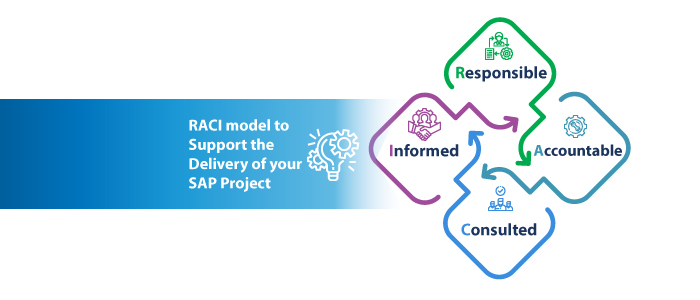One of the critical success factors of any SAP project is having clear definition around the roles and responsibilities for each project participant and key stakeholder. Regardless of how thorough and detailed a project plan may be, misunderstanding of team member roles and responsibilities is bound to cause significant issues.
A basic and effective practical approach to remedy this common problem is to define and document project roles and responsibilities via a RACI model. Integrating the RACI model into your projects deployment approach creates a powerful combination that boosts and expands project results. Further, incorporating a RACI model in your SAP services Statements of Work (SoW) can help support compliance with implementation partner contractual boundaries.

Four Pillars of the RACI* Model
The RACI model creates clarity and definition to describing the roles that stakeholders play within a SAP project. It’s a matrix to clarify individual responsibilities and to confirm that everything the project needs is assigned a corresponding ‘doer.’
To apply the RACI model utilizing best practices, you list every task, deliverable, work package, and then clarify who is Responsible, who is Accountable, who needs to be Consulted, or who needs to be Informed. The acronym RACI stands for the four roles that stakeholders might play in any SAP project:
- Responsible: People or stakeholders who are the ‘doers’ of the work or deliverable. They must complete the work package and/or make the decision. Several people can be jointly Responsible (e.g. Functional Consultant).
- Accountable: Person or stakeholder who is the ‘owner’ of the task. They must sign-off or approve when the work package or decision is complete. This person must be fully aligned with the overall RACI matrix to ensure responsibilities are assigned for all related tasks and activities. Best Practices state that there is only one person Accountable (e.g. Project Manager).
- Consulted: People or stakeholders who need to give input before the work package or decision can be completed and signed-off on. These people are often referred to as being ‘in the loop’ and active team members (e.g. SME).
- Informed: People or stakeholders who need to be kept ‘in the picture.’ They require updates on project progress and/or key decisions, but they do not need to be formally consulted, nor do they contribute directly to the work package or decision (e.g. VP, IT).
The following steps can be used to create a RACI model for any SAP project (refer to Exhibit 1 below):
- As part of Bramasol’s Discovery Phase, we’ll identify all the tasks involved in delivering the project and list them vertically on the left-hand side of the chart – typically in completion order. For SAP projects, this is most effectively addressed by incorporating in-scope, methodology deliverables.
- Identify all the affected project stakeholders and log them horizontally along the top of the chart.
- Complete the interior cells of the model by identifying who has Responsibility (R), Accountability (A); and who will be Consulted (C) and Informed (I) for each task.
- Ensure every task has at least one stakeholder Responsible for it.
- No tasks should have more than one stakeholder Accountable. Resolve any conflicts where there is more than one for a particular deliverable or work package.
- Collaborate and confirm alignment of the RACI model with your project stakeholders at the start of the SAP deployment. This includes resolving any conflicts.
EXHIBIT 1: SAMPLE RACI MODEL (small subsection of overall RACI Matrix)

* Note that an alternative version of the RACI Matrix include RASCI -- which could include Support personnel into the responsibility matrix. While not mandatory, Support personnel might be person(s) who can provide resources, information, or will generally support you in getting the work done.
RACI Benefits for Managers and Leaders
Leveraging a RACI model can help surface common organizational pain points and allow management to remedy challenges with regards to perceptions, role expectations, and performance.
Perception: How resources perceive their individual roles and required tasks become much clearer. Managers and Leaders will also attain a clearer picture of whether, or not, people are properly aligned to their respective positions.
Role Expectations: Resources in the organization can visualize what their, and others, position responsibilities are, and when associated tasks should be completed

